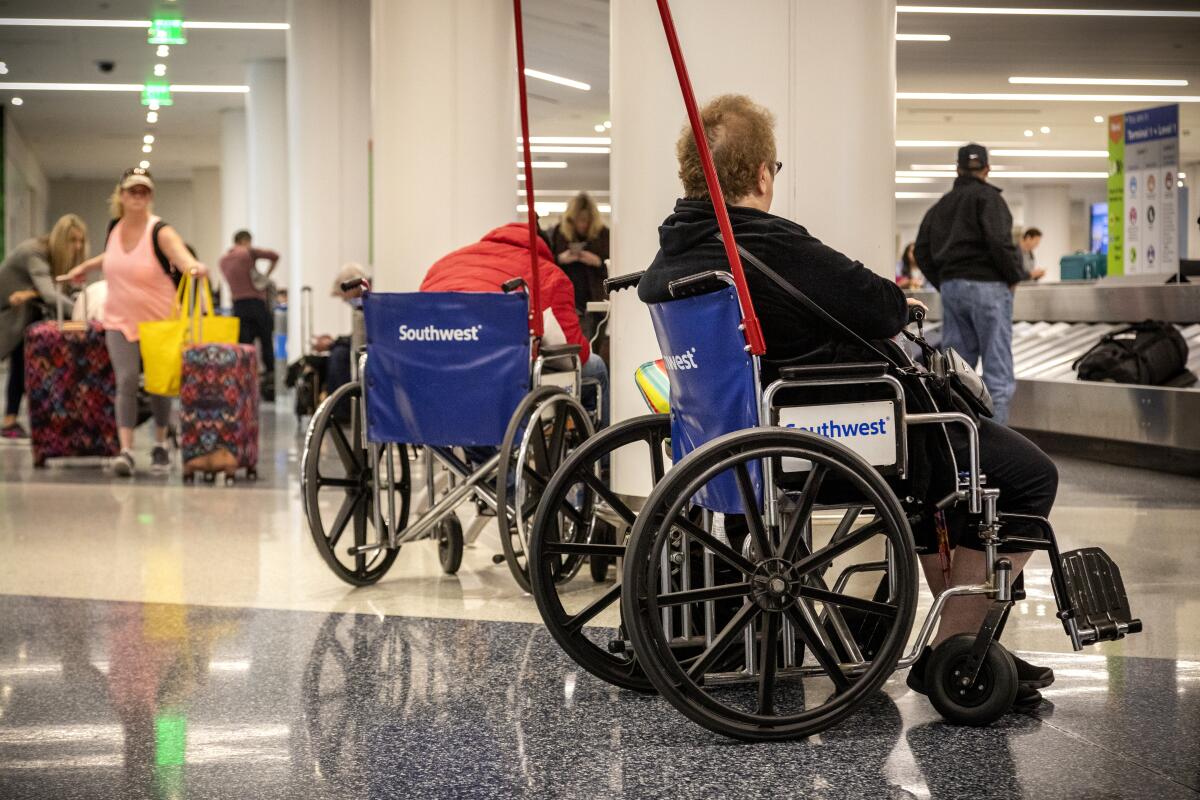Order a wheelchair at the airport well ahead of your flight

- Share via
If you (or a loved one) are flying and have a disability, brace yourself. Such a trip is rarely hassle-free.
At LAX, construction continues on the $14-billion upgrade to the airport. which means more obstacles than usual on your trip to the gate. When you come home, if you need a taxi or a ride-hail car, you’ll have a new system to navigate to get to the LAX-it (pronounced LA-exit) lot, where those vehicles await. It is, LAX officials said, fully accessible to travelers with disabilities.
Knowing first-hand the drama of traveling with a disability, I wondered how navigating the nation’s second busiest airport plays out for a traveler with mobility needs.
Ryan Easterly, a colleague, traveled on the first leg of a business trip from San Francisco International to LAX on Nov. 4.
“Bad news/good news about #LAX and #LAX-it,” he said in a Facebook post. “Bad news: It took 25 minutes to get wheelchair assistance upon arrival at LAX. (Mind you, they had my request on file, and I was the next-to-last person to exit the plane.)
“Good news ... there was zero wait time for the shuttle [to LAX-it] and it only took about 17 minutes from boarding the shuttle to being in a Lyft vehicle. So it went much better than expected.” The day Easterly traveled was just a week after the switch away from curbside pickup by taxis and ride-shares, which initially was plagued with confusion and delays.
Easterly, who uses crutches for mobility but always requests wheelchair assistance at the airport, said he found no shortage of helpful staff at the LAX-it lot, which is just east of Terminal 1.
Yes, you can carry a turkey in your suitcase, assuming it fits in the overhead compartment (the bag, not the turkey) and isn’t accompanied by more than 3.4 ounces of gravy and cranberry sauce.
On his return flight, Easterly said he waited 35 minutes for a wheelchair attendant to meet him at United Terminal 7 and take him to his gate.
Here’s some advice on how to plan for your access needs.
Wheelchair assistance
At LAX or any airport, the best way to request a wheelchair and someone to push it for you is to prearrange this service at least 72 hours in advance with your airline and confirm a day before you travel.
Holiday caveat: Do this earlier, at least a week ahead, during busy holiday periods.
If you forget this step or find you need service on demand, that’s usually OK. Immediate assistance at the airline check-in counter is available, but be prepared to wait, depending on demand.
“Though we normally ask that our guests give themselves two hours before departure for a domestic flight and three hours [before] departure for an international flight, those requesting wheelchair assistance should try to plan for an additional half-hour on top of normal recommendations,’’ Heath Montgomery, LAX spokesman, said in an email.
Holiday caveat: You may need even more time. Better to err on the side of caution.
People who assist passengers with wheelchairs are contractors who work for the airlines. The scope of service is limited.
What they will do: push you through the airport, through Transportation Security Administration checkpoints, take you to food trucks or shops if you request it, drop you off or pick you up at the gate.
What they will not do: provide any personal care, such as toileting or feeding. They are not trained for this, Montgomery said. If you need this type of access support, you’ll need to bring someone with you.
For the Thanksgiving holiday, Amtrak’s Pacific Surfliner requires reservations. You could take a bus, with help from a new site, or even rent a Tesla.
If you’re making travel arrangements for someone who requires assistance with personal care, has difficulty following directions or may become confused in the busy airport, such as a person with Alzheimer’s or other dementia, arrange for a family member to travel with that person or hire a travel companion. (Google “travel companion” and you will find several organizations that offer this service.)
For a February column about how people living with dementia can travel safely, experts offered excellent advice, including these nuggets:
• Consider the person’s optimal time of day and try to make flight arrangements for those hours. Also be sure that neither the person living with dementia nor the travel companion is hungry.
• Make sure the companion and the person living with dementia carry identification at all times.
• Someone, whether it’s the caregiver or a family member, should speak with airline staff, Transportation Security Administration agents and the airline’s gate and on-board crew, to alert them about the person’s condition.
• Airports can be noisy and disorienting (sometimes chaotic, especially at the holidays), so consider packing reading material or electronic devices (music or movies appropriate to the person’s age are a good idea).
Dealing with hailing a taxi or a ride
If you need a cab or ride-share service once you land, you’ll need to make your way to the LAX-it lot using a new, bright green shuttle bus.
Shuttles are free, run every three to five minutes and have ramps for wheelchair boarding, but the buses are also low enough so you can easily step on if you’re not using a chair. Accessible seating is near the front of the bus.
“If a passenger needs additional assistance, the guest should ask staff to call for a special ADA bus in which the drivers are trained to assist people with disabilities,” Montgomery said.
The LAX-it lot has four accessible restrooms with adult changing stations. Crosswalks are at grade, so there are no ramps to maneuver.
Wheelchairs also are available upon request when arriving at LAX-it, and the LAX-it shuttle driver can call for one to be waiting for the guest upon arrival at LAX-it, Montgomery said.
Have more questions?
More information about LAX is available at bit.ly/LAXdisabilitytravel.
The Alzheimer’s Assn. helpline is (800) 272-3900 and is staffed by clinicians around the clock and accommodates 200 languages. If a crisis occurs during a trip, don’t hesitate to call. More information: alz.org. For holiday-specific concerns: bit.ly/alzheimersholiday
More to Read
Sign up for The Wild
We’ll help you find the best places to hike, bike and run, as well as the perfect silent spots for meditation and yoga.
You may occasionally receive promotional content from the Los Angeles Times.







